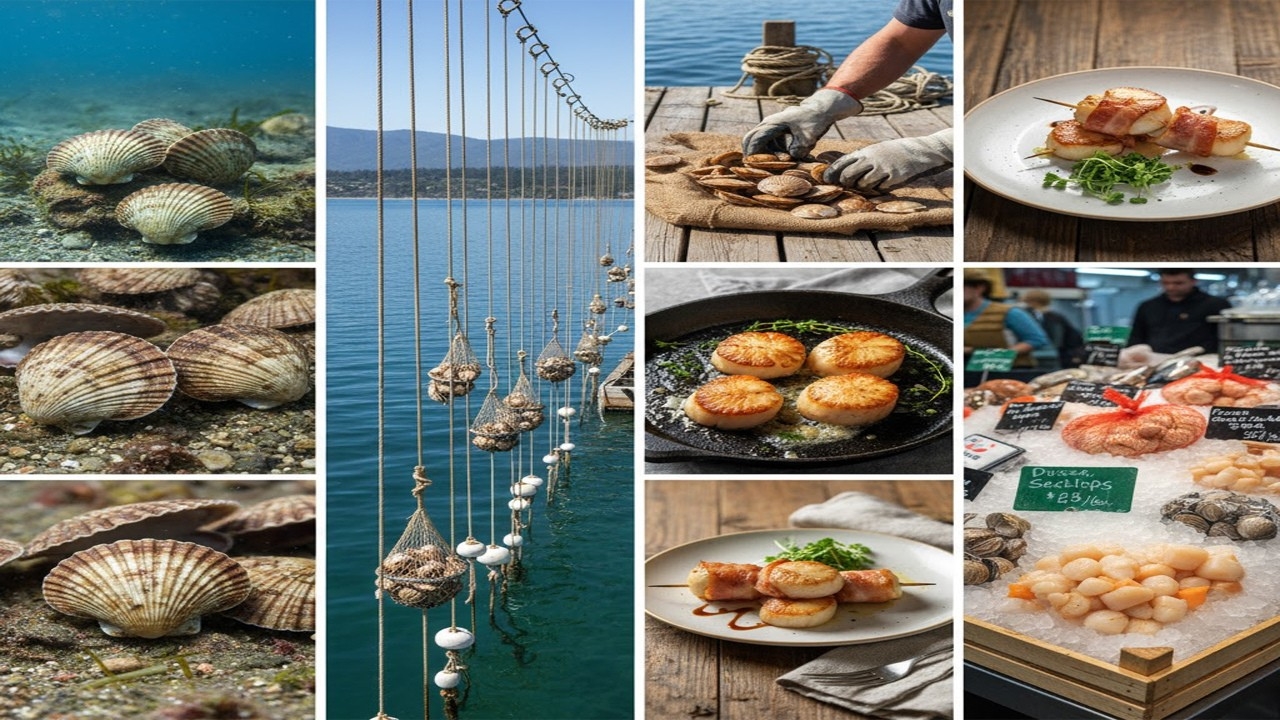Join on WhatsApp
Get the latest updates directly on WhatsApp – motivation, news & more!
Scallops are a prized seafood delicacy known for their sweet flavor and tender texture. They belong to the mollusk family and are found in oceans worldwide. Among the most popular types are sea scallops, bay scallops, king scallops, queen scallops, diver scallops, dayboat scallops, and weathervane scallops. Each variety differs in size, taste, and harvesting method. Wild scallops are often considered superior in flavor, while farmed scallops offer sustainability and year-round availability.
Scallops in the Ocean: Natural Habitat and Lifecycle
Scallops thrive in cold, clean waters, typically on sandy or muddy ocean floors. They are filter feeders, drawing plankton and nutrients from the water. Scallops in the ocean exhibit a unique behavior—they can swim short distances by clapping their shells together. Their lifecycle includes a larval stage, settlement, and growth into mature scallop fish. Understanding this lifecycle is essential for successful aquaculture.
Sustainable Scallop Farming Techniques
Growing scallops sustainably involves mimicking their natural environment while minimizing ecological impact. Ear-hanging and lantern net methods are widely used. Ear-hanging involves attaching juvenile scallops to ropes suspended in the water column, allowing better water flow and growth. Lantern nets stack scallops vertically, ideal for limited space. Tools like underwater cameras, temperature sensors, and plankton monitoring systems help optimize conditions. Dry packed scallops and hand dived scallops are often preferred for their freshness and minimal processing.
Preparing for Scallop Cultivation
Before starting a scallop farm, selecting the right site is crucial. Water temperature should range between 10–15°C, with good tidal flow and low pollution. Live scallops are introduced into the system, often sourced from hatcheries. Farmers monitor growth rates, shell integrity, and meat quality. Scallop meat develops best in nutrient-rich waters, and regular cleaning of farming gear prevents biofouling.
Harvesting and Post-Harvest Handling
Scallops are typically harvested after 12–24 months, depending on species and conditions. Once collected, they are sorted by size—u10 scallops, u8 scallops, 10 20 scallops, and colossal scallops are common grading standards. Fresh scallops are immediately chilled or frozen to preserve quality. Dry scallops, frozen sea scallops, and frozen bay scallops are popular in retail. Smoked scallops and canned scallops offer longer shelf life.
Buying and Selling Scallops
Scallops for sale are available through various channels. Consumers can buy scallops online, order scallops online, or find scallops for sale near me. Retailers like Aldi scallops, Tesco scallops, Sainsburys scallops, Woolworths scallops, Coles scallops, Publix scallops, Kroger scallops, Lidl scallops, Iceland scallops, M&S scallops, Wegmans scallops, and Sprouts scallops offer fresh and frozen options. Scallops price per pound varies by type and origin, with fresh sea scallops and jumbo sea scallops commanding premium rates.
Cooking Scallops: Techniques and Tips
Cooking scallops requires precision to preserve their delicate texture. Pan searing scallops is a classic method—achieving a golden crust while keeping the center tender. Cooking scallops in a pan or cooking scallops on stove should be done over medium-high heat with minimal oil. Pan fried scallops and sauteed scallops are quick and flavorful. Baked scallops and stuffed scallops offer comforting, oven-based alternatives. Fried scallops and potato scallop are popular in casual dining, especially in coastal regions.
Creative Scallop Recipes
Scallops pair well with various ingredients. Bacon wrapped scallops and scallops and bacon are savory favorites. Frozen bacon wrapped scallops offer convenience without sacrificing taste. Raw scallops and scallop sashimi are enjoyed in Japanese cuisine, especially with fresh scallops and japanese scallops. Vegetarian scallops made from plant-based ingredients mimic the texture for alternative diets. Cooking sea scallops with butter, garlic, and herbs enhances their natural sweetness.
Where to Find Fresh Scallops
Finding fresh scallops near me or sea scallops near me depends on location and season. Seafood scallops are often available at fish markets and specialty stores. Buy fresh scallops from trusted vendors to ensure quality. Scallops delivery services offer convenience, especially for frozen scallops and dry scallops near me. Fresh sea scallops near me and bay scallops near me are best sourced locally for optimal freshness.
Specialty Scallops and Global Varieties
Scallops come in diverse forms across the globe. Patagonia scallops and Peruvian scallops are known for their unique flavor profiles. Red lobster scallops and Omaha Steaks stuffed sole feature scallops in restaurant-style dishes. Whole scallops and scallop powder are used in gourmet cooking. Seatrade scallops and scallops online platforms cater to bulk buyers and chefs seeking premium ingredients.
Pricing and Market Trends
Scallops cost varies based on size, origin, and freshness. Scallops price fluctuates seasonally and by demand. Scallops per pound is a common metric for retail and wholesale. Best scallops to buy include dry sea scallops, large sea scallops, and jumbo scallops. Best frozen scallops offer convenience without compromising taste. Preparing scallops properly ensures value for money and culinary satisfaction.
Conclusion: The Future of Scallop Aquaculture
Scallop farming is a promising avenue for sustainable seafood production. With growing demand for fresh scallops, scallops woolworths, scallops coles, and scallops sainsburys continue to expand their offerings. As consumers seek quality and traceability, scallop fish cultivation must balance innovation with environmental stewardship. Whether you’re cooking scallops, buying scallops near me, or exploring scallops delivery, understanding the journey from ocean to plate enriches every bite.
